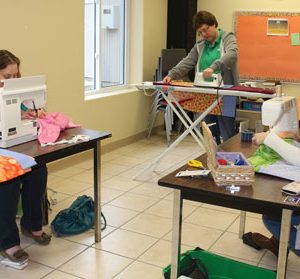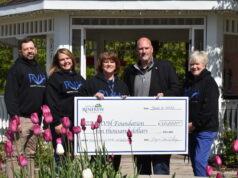Group photo 1:Those who sewed on Saturday were, front row from left: Diane Greer, Olivia Greer, Ruby Greer, Sadie-May Pilgrim, Kelly Levi and Brenda McLeod. Back row from left: Hennie Clemmer, Sherry Grant, Cheryl Bennett, Denise Bennett, Dwylla MacPherson, Carol Harrington, Joan Phillips, Barb Thibeau and Kim Durant.
Group photo 2: Sewing on Saturday are, front row from left: Renie Takken, Mattea Schaap, Gloria Leger, Adrianna VanLindenberg and Anne Marie Schaap. Back row from left: Erica Vong, Judy Greer, Elaine Snider, Karen Gilks, Lisa Takken, Lily Peever, Coralie Kirk, Sandy Brander, Catrina VanLindenber and Doris Reaney.
by CONNIE TABBERT
Editor
COBDEN — Thirty women and girls spent four hours Saturday making bright, colourful sun dresses in the community room at Whitewater Wesleyan Church.
When the dresses are ready to be worn, a label is sewn on the front of the dress near the hemline. On the label it says, Dress a Girl Around the World.
It’s hoped the label will protect a young girl from being attracted to predators who want to remove her illegally from her family for, most likely, the sex trade.
Doris Reaney, the pastor’s wife at the Wesleyan Church, said she heard about Dress a Girl Around the World while at a conference.
“I heard about it at a conference where Karen Gilks made a presentation,” she recalled. “It rang a bell with me. I knew right away this is something our ladies can do. And so, I brought it up at a ladies retreat and they just jumped on board.”
Ms. Gilks said she heard about Dress A Girl Around the World and attended a workshop to learn more about the initiative. Explaining, she said missionaries go into villages and very poor sections of cities and teach women how to protect their children against predators involved with human trafficking. When the women who attend these seminars leave, they are given a dress for each of their daughters, usually between the ages of two to 11, she said.
“Those little labels sewn on the dresses are to let predators know that the family knows what’s going on and how to protect their children,” she said, adding, “They feel like these girls are being watched by an organization. And so, hands off.”
The families in the villages are trained on how predators are able to take children and get them involved in sex trades, she said.
“The people, especially the moms, are encouraged to come to a seminar and listen about anti-trafficking and how to protect children against predators,” Ms. Gilks said. “Then they are given a dress. There’s no use handing out the dress if they don’t understand this whole thing about anti-trafficking.
When the women of the church learned about the organization, they agreed to make the dresses, Ms. Reaney said. At a ladies retreat last month, an offering was taken up to raise money for the necessary materials, she said. As well, some women donated material.
Ms. Reaney added, “One lady donated enough material for 50 dresses. For the other 50, we bought the material. Our goal is to make 100 dresses.”
However, it’s not just this church making the dresses, she said. She knows of other churches that are making dresses for Dress A Girl Around the World.
Last Saturday, from 10 a.m. until 2 p.m., the 30 or so women and girls came together, set up various stations, and began creating the dresses. Ms. Reaney noted the 100 dresses won’t be made in that amount of time. Some of the women will take material home to continue making them, and the Ladies With A Mission, who meet twice a month at the church, will also make some dresses, she added.
“The Ladies With a Mission, who meet every other Monday, and who usually make quilts, will take on some of these dresses,” she said. “We’ll finish up after today. We won’t make 100 today, but if we make 50 I’ll be happy.”
Ms. Gilks is hopeful the 100 dresses will be ready by April, so she will be able to take them to the Wesleyan Women’s Conference in Roblyn, Ontario to be put with others that are being made. She noted there are missionaries heading to Cambodia with 10 suitcases, which will hopefully be filled with dresses. However, if there are more of the garments, they will be sent with missionaries to other countries where they are needed, she added.
There are currently close to 100 countries where the dresses go, she said. Since starting years ago, 300,000 of these labelled dresses have been delivered around the world, she noted.
Ms. Gilks noted it’s not just third world countries where there are predators. Recently, 200 dresses were given out in a very poor section of Vancouver, British Columbia.
“Even our own country, Canada, we’re not without predators,” she said. “We had to deliver a bunch to Vancouver because there’s trafficking going on there.”
It’s usually the teenaged girls who are promised jobs, such as a secretary or nurse, in a far-off country, she said.
“What we’re trying to do is catch the girls before they are teenagers, help them understand about predators,” she said. “The mothers must have an understanding and must be able to teach their daughters. They shouldn’t wait until it’s too late. We need to educate the young.”
Ms. Gilks read a paragraph from the Dress A Girl Around the World web site: Please help protect us from predators by allowing us to wear a good quality dress with the Dress A Girl label on the outside. The label indicates that an organization is looking after us and just maybe a predator will pass over us. Even if it saves one of us.
Ms. Gilks said this is the first time she has attended a church group where the dresses are being made. She provided a short talk to the women about Dress A Girl Around the World. While she made the initial presentation, Ms. Gilks said, “Doris will take the leadership here at this church.”
She said it’s great to see women and girls working together on a project.
“It’s so wonderful,” she said. “I love it that the young and old are involved in it. It’s nice to see the young girls sewing. It’s a lost art.
“If the old can teach the young, that’s just wonderful.”
Just before lunch, Ms. Reaney spoke to the women.
“It’s been a really good morning,” she said. “It’s wonderful to see these dresses taking shape. I’m enjoying the colours and, seeing all this production is just a delight.”
Ms. Gilks explained that it’s important to make the dresses from brightly coloured, 100 percent cotton material.
“They love bright colours, they make them feel special,” she said. “The dresses need to be made of 100 percent cotton because in countries where heat is a factor, cotton –is best. It’s also very durable. They’ll most likely wash them in rivers and clean them there, so they’ll be scrubbing them on rocks. Cotton just wears well.”
Ms. Reaney added, “This is really great. This is something I really think our ladies can do.”







![Kenopic/Smith Auction [Paid Ad]](https://whitewaternews.ca/wp-content/uploads/2018/10/advertising-100x75.jpeg)

